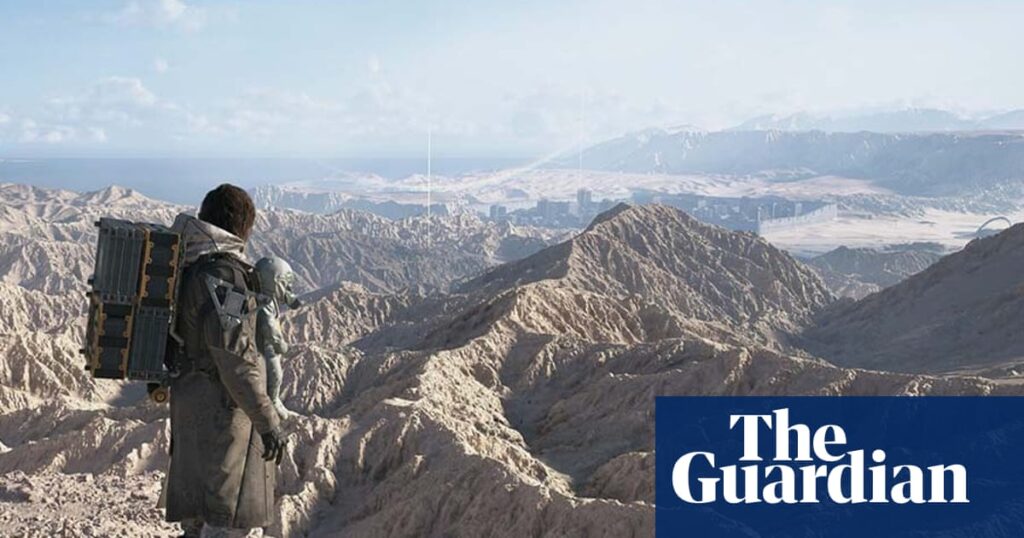
As a teenager in the late 1980s, I became captivated by Australian new wave cinema. This fascination was sparked by the Mad Max trilogy and an English teacher who introduced us to Nicolas Roeg’s masterpiece, Walkabout. Decades later, playing Death Stranding 2, Hideo Kojima’s expansive apocalyptic adventure, I find myself transported back to that classroom. Most of the game unfolds in a devastated Australia, a landscape as stark, beautiful, and foreboding as in Roeg’s film.
Having invested 45 hours into the game, I’ve barely scratched the narrative’s surface. Instead, I’ve roamed the wilderness, delivering packages to isolated communities. Set in a world ravaged by a catastrophic event, humanity is decimated, and supernatural explosions have scarred the landscape. Players traverse vast ochre deserts toward the coast, witnessing sunsets behind glowing mountains and tides rolling into empty bays. Unlike typical open-world games where landscapes remain static, Death Stranding 2 presents a mysterious, ever-changing Australia. Earthquakes, dust storms, and avalanches constantly reshape the terrain, while players can construct roads and facilities, which may be used by others, ensuring the environment is never truly still.
The Cinematic Inspirations Behind Death Stranding 2
Kojima has cited George Miller, creator of the Mad Max series, as a major influence, and the desolate energy of those films permeates this game. The interplay of technology and isolation, feudal tribes, and scarce resources echo Miller’s work. Kojima’s admiration for Walkabout is also evident, with its mythic energy, though perhaps without the colonial guilt undertone. A remote rocky outcrop in the game evokes Peter Weir’s Picnic at Hanging Rock, with its labyrinthine crevices and unnerving silence.
In this digital Australia, I’ve spent countless hours driving along highways, delivering parcels to strange, inaccessible places. The question arises: why? Why am I drawn to ensuring an animal shelter receives its delivery of fluffy pajamas at 2 a.m.? The answer lies in Kojima’s creation of a timeless yet volatile version of Australia. It’s a world that is both beguiling and threatening, drawing players into its seductive embrace.
Crafting a Hallucinatory Experience
Years ago, Peter Weir described his approach to Picnic at Hanging Rock: “What I attempted was to develop the oppressive atmosphere of something which has no solution: to bring out a tension and claustrophobia in the locations and the relationships. We worked very hard at creating a hallucinatory mesmeric rhythm, so that you lost awareness of facts, you stopped adding things up, and got into this enclosed atmosphere.”
“I did everything in my power to hypnotize the audience away from the possibility of solution.”
This encapsulates my experience with Death Stranding 2. The game’s hallucinatory rhythms draw players into a cycle of exploration and discovery. Hours later, you may find yourself back in familiar territory, but with new roads or signs left by other players. What Grand Theft Auto attempts with American cities, Kojima achieves with the Australian outback, distilling the essence of a place from an outsider’s perspective. Each new area unlocked feels like discovering an alien landscape, rich with beauty, possibility, and danger.
The Broader Gaming Landscape
Meanwhile, in the broader gaming world, other titles are making waves. Quantum Witch, created by Nikki Jay, offers a unique pixel art adventure inspired by her experiences escaping a religious cult. With help from Paul Rose, it blends point-and-click mechanics with postmodern deconstruction, appealing to fans of offbeat narratives.
In contrast, MindsEye by Build a Rocket Boy faces challenges, with significant job cuts following a troubled launch. Plagued by bugs and AI glitches, the game received negative reviews, leading to potential layoffs of up to 100 staff members. This situation underscores the volatile nature of the gaming industry.
Looking Forward
As Death Stranding 2 continues to captivate players with its enigmatic world, it raises questions about the future of storytelling in video games. Kojima’s ability to weave cinematic influences into interactive experiences sets a high bar for narrative depth and environmental immersion. As players explore this digital Australia, they are reminded of the power of games to evoke emotion and provoke thought, much like the films that inspired them.
The journey through Death Stranding 2 is far from over. As players continue to uncover its mysteries, the game promises to remain a topic of discussion and analysis, much like the cinematic masterpieces that influenced its creation.







